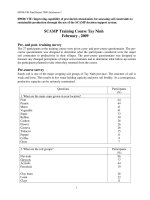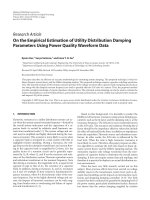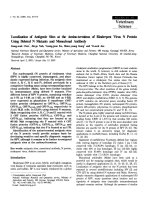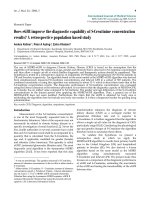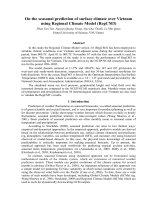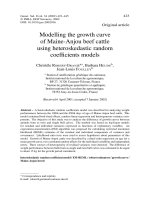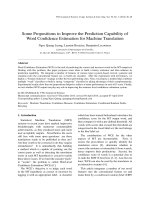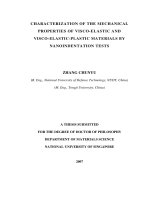researching the manufacturing capability of moment compliant soft structures using plastic injection molding method
Bạn đang xem bản rút gọn của tài liệu. Xem và tải ngay bản đầy đủ của tài liệu tại đây (9.16 MB, 126 trang )
<span class="text_page_counter">Trang 1</span><div class="page_container" data-page="1">
<b> </b>
<b>TECHNOLOGY AND EDUCATION</b>
MINISTRY OF EDUCATION AND TRAINING
<b>HO CHI MINH CITY UNIVERSITY OF </b>
<b>GRADUATION THESIS</b>
<b>FUNDAMENTALS OF MACHINE DESIGN </b>
<b>LECTURER: Ph.D. NGUYEN TRONG HIEU STUDENT: MAI DANG KHOA</b>
<b> NGUYEN ANH KHOA MAI TRAN XUAN PHONG</b>
<b>Ho Chi Minh City, March 2024</b>
<b>RESEARCHING THE MANUFACTURING CAPABILITY OF MOMENT-COMPLIANT </b>
<b>SOFT STRUCTURES USING PLASTIC INJECTION MOLDING METHOD </b>
</div><span class="text_page_counter">Trang 2</span><div class="page_container" data-page="2">Ministry of Education and Training
HO CHI MINH CITY UNIVERSITY OF TECHNOLOGY AND EDUCATION
<small>¯¯¯¯¯¯¯¯¯¯¯¯¯¯¯¯¯¯¯¯¯¯¯¯¯¯¯¯¯¯¯¯¯¯¯¯¯¯¯¯¯¯¯¯¯¯¯¯¯¯ </small>
F ACULTY OF INTERNATIONAL EDUCATION
GRADUATION THESIS
Ho Chi Minh City, March 2024
RESEARCHING THE MANUF ACTURING CAPABILITY OF MOMENT-COMPLIANT SOF T
STRUCTURES USING PLASTIC INJ ECTION MOLDING METHOD
Instructor: Ph.D. NGUYEN TRONG HIEU
Students: MAI DANG KHOA ID: 19143086 NGUYEN ANH KHOA ID: 19144087 MAI TRAN XUAN PHONG ID: 19144073
</div><span class="text_page_counter">Trang 3</span><div class="page_container" data-page="3">Ministry of Education and Training
HO CHI MINH CITY UNIVERSITY OF TECHNOLOGY AND EDUCATION
Instructor: Ph.D. NGUYEN TRONG HIEU
Students: MAI DANG KHOA 19144086 NGUYEN ANH KHOA 19144087 MAI TRAN XUAN PHONG 19144073
Ho Chi Minh City, March 2024
</div><span class="text_page_counter">Trang 4</span><div class="page_container" data-page="4">i HCMC UNIVERSITY OF
TECHNOLOGY AND EDUCATION F aculty of International Education
THE SOCIALIST REPUBLIC OF VIETNAM Independence – F reedom – Hapiness
----o0o----
Ho Chi Minh City, March 21, 2024
MISSION OF THE GRADUATION THESIS
Advisor: Ph.D. NGUYEN TRONG HIEU
Athor’s name: MAI DANG KHOA ID: 19144086 NGUYEN ANH KHOA ID: 19144087 MAI TRAN XUAN PHONG ID: 19144073 1. Thesis ID: CTM-48
- Researching the manufacturing capability of moment-compliant soft structures using plastic injection molding method.
2. Initial data, documents, and sources: - Size and structure: Refer to previous studies.
- Injection mold specifications: According to the mold design curriculum and injection molding machine specifications at the University of Technology and Education.
3. The main content of the thesis:
- Overview of plastic injection molding technology. - Overview of the moment-compliant soft musculature. - Mold design for soft structures.
- Mold manufacturing, assembly and testing. - Summarize results.
4. Expected outcomes or products: - Product model.
- Project report.
5. Date of assignment for the thesis: 1/10/2023 6. Deadline for submitting the thesis:
Defense presentation: English Vietnamese
<i>(Signature, clearly stating full name) </i>
<i>(Signature, clearly stating full name) </i>
<i>(Signature, clearly stating full name) </i>
<small> </small>
</div><span class="text_page_counter">Trang 5</span><div class="page_container" data-page="5">ii HCMC UNIVERSITY OF
TECHNOLOGY AND EDUCATION F aculty of International Education
THE SOCIALIST REPUBLIC OF VIETNAM Independence – F reedom – Hapiness
----o0o----
Ho Chi Minh City, March 21, 2024
ASSESSMENT F ORM OF INSTRUCT LECTURER
Full name of student 1: MAI DANG KHOA Student ID: 19144086 Full name of student 2: NGUYEN ANH KHOA Student ID: 19144087 Full name of student 3: MAI TRAN XUAN PHONG Student ID: 19144073 Full name Instructor: Ph.D. NGUYEN TRONG HIEU
<i><b>Thesis: Researching the manufacturing capability of moment-compliant soft </b></i>
structures using plastic injection molding method. COMMENT:
1. Regarding the topic content and implementation volume:
... ... ... 2. Pros:
... ... 3. Cons:
... 4. Recommend for defend graduation thesis or not?
... 5. Type rating:
... 6. Score: ... (In words: ... )
INSTRUCTORS (Sign and write full name)
</div><span class="text_page_counter">Trang 6</span><div class="page_container" data-page="6">iii HCMC UNIVERSITY OF
TECHNOLOGY AND EDUCATION F aculty of International Education
THE SOCIALIST REPUBLIC OF VIETNAM Independence – F reedom – Hapiness
----o0o----
Ho Chi Minh City, March 21, 2024
ASSESSMENT F ORM OF DECIPATION LECTURER
Full name of student 1: MAI DANG KHOA Student ID: 19144086 Full name of student 2: NGUYEN ANH KHOA Student ID: 19144087 Full name of student 3: MAI TRAN XUAN PHONG Student ID: 19144073 Full name Instructor: Ph.D. NGUYEN TRONG HIEU
<i><b>Thesis: Researching the manufacturing capability of moment-compliant soft </b></i>
structures using plastic injection molding method. COMMENT:
1. Regarding the topic content and implementation volume:
... ... ... 2. Pros:
... ... 3. Cons:
... 4. Recommend for defend graduation thesis or not?
... 5. Type rating:
... 6. Score:………(In words:………...)
INSTRUCTORS (Sign and write full name)
</div><span class="text_page_counter">Trang 7</span><div class="page_container" data-page="7">iv HCMC UNIVERSITY OF
TECHNOLOGY AND EDUCATION F alcuty of International Education
THE SOCIALIST REPUBLIC OF VIETNAM Independence – F reedom – Hapiness
Project Executor
Student 1 Mai Dang Khoa
Student 2 Student 3
Nguyen Anh Khoa Mai Tran Xuan Phong
</div><span class="text_page_counter">Trang 8</span><div class="page_container" data-page="8">v
ACKNOWLEDGEMENT
We could not have successfully completed our graduation project without the support of everyone around us. Thanks to the dedicated and passionate teaching of our instructors, who imparted knowledge and supported us throughout our learning journey. With deep appreciation, we sincerely thank:
<i><b>✓ Assoc. Prof. Ph.D. Pham Son Minh - our main project supervisor, who </b></i>
patiently guided and provided favorable conditions for us during the project implementation. He always took the time to make detailed corrections and give instructions to achieve the best results.
<i><b>✓ Ph.D. Nguyen Trong Hieu - project leader for his dedicated guidance in the </b></i>
process of researching, designing and manufacturing plastic injection molds to create soft moment structure models.
<i><b>✓ Ph.D. Tran Minh The Uyen - for providing equipment and tools that made </b></i>
our graduation project more efficient.
✓ We would also like to acknowledge the faculty members at Ho Chi Minh City University of Technology and Education for their dedication to teaching and their contributions to our academic development.
✓ Lastly, we extend our gratitude to the Board of Directors of the university for creating a conducive environment that supports students and learners in their research and projects.
In conclusion, we wish to express our heartfelt appreciation to all the instructors for their dedication and tireless efforts. We wish them good health, happiness, and youthful spirits as they continue to educate future generations.
<i><b>Author </b></i>
</div><span class="text_page_counter">Trang 9</span><div class="page_container" data-page="9">Target: Apply and maximize the knowledge learned in the field molds in particular and mechanics in general. The group has researched, designed and manufactured a set of plastic injection molds for soft moment structures.
Content:
• Knowledge of injection molds.
• Knowledge of moment-compliant soft structures. • Fabrication and assembly.
• Testing injection mold.
Conclusion: After completing the project. The resulting product is a complete set of injection molds and can be used in research and production with high automation. Besides, our team has gained more practical knowledge in the mold making process, thereby helping us to have more confidence when entering the actual work later. However, in the process of making, there are many mistakes due to lack of experience, leading to repeated corrections and time consuming.
</div><span class="text_page_counter">Trang 10</span><div class="page_container" data-page="10">vii
TABLE OF CONTENTS
MISSION OF THE GRADUATION THESIS ... i
ASSESSMENT F ORM OF INSTRUCT LECTURER ... ii
ASSESSMENT F ORM OF DECIPATION LECTURER ... iii
LIST OF F IGURES ... xiii
LIST OF ABBREVIATION... xvi
CHAPTER 1: OVERVIEW ... 1
1.1 Overview of moment-resisting soft structure. ... 1
1.2 Overview of the Constant-Torque Joint Mechanism (CTJM) ... 1
1.3 Reasons for choosing the topic ... 3
1.3.1 Why choose the CTJM structure ... 3
1.3.2 Why choose moment-resisting soft structures using the plastic injection molding method? ... 4
1.4 Topic objective ... 5
1.5 Research methods ... 5
1.6 Research scope ... 5
CHAPTER 2: THEORETICAL BASIS ... 7
2.5 Choose soft structures ... 7
</div><span class="text_page_counter">Trang 11</span><div class="page_container" data-page="11">viii
2.1 Overview of mold ... 9
2.2 Overview of plastic injection molding ... 9
2.2.1 Plastic injection molding technology ... 9
2.2.2 Overview of plastic injection machines ... 11
2.3 Classification of plastic injection molds ... 14
2.3.1 Two-plate mold. ... 14
2.3.2 Three-plate mold. ... 16
2.4 Overview of PP plastic (Polypropylene) ... 18
CHAPTER 3: DESIGN AND F ABRICATION OF MOLDS ... 21
3.1 Redesign product: ... 21
3.2 Shrinkage coefficient of the product... 23
3.3 Manufacturing the mold ... 23
3.3.1 Mold release angle ... 23
3.3.2 Calculate the number of mold cavities [6]. ... 23
3.3.3 Mold separation ... 26
3.4 Plastic runner design ... 30
3.4.1 Sprue bushing design... 30
3.4.2 Calculate runner diameter ... 31
3.4.3 The nozzle ... 32
3.5 Designing the ejection system ... 34
3.6 Designing the cooling system ... 35
3.7 Analysis of simulation results. ... 40
3.8 Selecting standard components... 48
</div><span class="text_page_counter">Trang 12</span><div class="page_container" data-page="12">4.2 Manufacturing process of core plate... 54
4.2.1 Routing 1: Milling bottom surface, the side surface and machining holes ... 54
4.2.2 Rough 2: Milling top surface, 2 sides left, insert cavity ... 61
4.2.3 Manufacturing process of cavity plate ... 64
4.3 Deburring and polishing ... 66
Limitations of the project: ... 79
Development and orientation ... 80
REF ERENCES ... Error! Bookmark not defined. APPENDIX ... 81
</div><span class="text_page_counter">Trang 13</span><div class="page_container" data-page="13">x
Milling mold cavity and machining holes ... 83
Manufacturing process of top clamp plate... 86
Rough 1: Milling bottom surface, 2 sides surface and machining holes ... 86
Rough 2: Milling top surface and another sides surface ... 90
Manufacturing process of spacer block ... 91
Rough 1: Milling bottom surface, 2 sides surface and machining holes ... 91
Rough 2: Milling top surface and another sides surface ... 93
Manufacturing process of retainer plate ... 94
Rough 1: Milling bottom surface, 2 sides surface and machining holes ... 94
Rough 2: Milling top surface and another sides surface ... 98
Manufacturing process of ejector plate... 99
Rough 1: Milling bottom surface, 2 sides surface and machining holes ... 99
Rough 2: Milling top surface and another side surfaces ... 101
Manufacturing process of bottom plate ... 102
Rough 1: Milling bottom surface, 2 sides surface and machining holes ... 102
Rough 2: Milling top surface and another sides ... 105
</div><span class="text_page_counter">Trang 14</span><div class="page_container" data-page="14">xi
LIST OF TABLES
Table 2.1: The physical characteristics of PP plastic ... 20
Table 2.2: The mechanical properties of PP plastic ... 19
Table 2.3: Compare 2 type of soft structure ... 8
Table 3.1: Redesign product ... 21
Table 3.2: Table caculate number mold cavities ... 26
Table 3.3: Create workpiece and separate mold ... 26
Table 3.4: Designing cooling system using NX software. ... 38
Table 4.1: Dimensions of the mold parts ... 53
Table 4.2: Manufacturing process of core plate in rough 1 ... 58
Table 4.3: Manufacturing process of core plate in rough 2 ... 61
Table 4.4: Manufacturing process of core plate in rough 3 ... 63
Table 4.5: Manufacturing of cavity plate in rough 1 ... 64
Table 4.6: Mold assembly ... 72
Table 4.7: Input parameter ... 77
Table 4.8: Manufacturing of cavity plate in rough 2 ... 83
Table 4.9: Manufacturing of top clamp plate in rough 1 ... 86
Table 4.10: Manufacturing of top clamp plate in rough 2 ... 90
Table 4.11: Manufacturing of spacer block in rough 1 ... 91
Table 4.12: Manufacturing of spacer block in rough 2 ... 93
Table 4.13: Manufacturing of retainer plate in rough 1 ... 94
Table 4.14: Manufacturing of retainer plate in rough 2 ... 98
Table 4.15: Manufacturing of ejector plate in rough 1 ... 99
</div><span class="text_page_counter">Trang 15</span><div class="page_container" data-page="15">xii Table 4.16:Manufacturing of ejector plate in rough 2 ... 101Table 4.17: Manufacturing of bottom plate in rough 1 ... 102Table 4.18: Manufacturing of bottom plate in rough 2 ... 105
</div><span class="text_page_counter">Trang 16</span><div class="page_container" data-page="16">Figure 2.3: Plastic injection molding machine [3] ... 11
Figure 2.4: Spray system [3] ... 13
Figure 2.5: Basic two-plate mold [4]. ... 15
Figure 2.6: Three-plate mold [5]. ... 17
Figure 2.7: Polypropylene plastic [5]. ... 18
Figure 3.1: The mass and volume of the detail ... 22
Figure 3.2: Calculate the dimensions of the sprue ... 31
Figure 3.3: Table of common cross-sectional types of plastic runners ... 31
Figure 3.4: Fan gate [7] ... 32
Figure 3.5: Caculate fan gate [7]. ... 33
Figure 3.6: Fan gate ... 33
Figure 3.7: Fan gate ... 34
Figure 3.8: Ejection system ... Error! Bookmark not defined.Figure 3.9: The importance of mold cooling time [7]... 35
Figure 3.10: Design cooling system ... 36
Figure 3.11: Cooling system ... 37
Figure 3.12: Filling Melt Front Time ... 40
Figure 3.13: Air trap ... 41
Figure 3.14: Pressure ... 42
</div><span class="text_page_counter">Trang 17</span><div class="page_container" data-page="17">xiv
Figure 3.15: Temperature ... 43
Figure 3.16: Temperature ... 44
Figure 3.17: Filling volumetric shrinkage ... 44
Figure 3.18: The temperature of the product after the cooling process ... 45
Figure 3.19: The efficiency of the cooling system ... 46
Figure 3.20: The product's curvature due to temperature and shrinkage. ... 47
Figure 3.21: The parameters for evaluating the curvature of the product ... 47
Figure 3.22: Sprue bushing according to Misumi standard [8]. ... 48
Figure 3.23: Locating ring according to Misumi standard [8]. ... 49
Figure 3.24: Return pin according to Misumi standard [8]... 49
Figure 3.25: Guide pin according to Misumi standard [8]. ... 50
Figure 3.26: Guide bushing according Misumi standard [8]. ... 51
Figure 3.27: Ejector pin according to Misumi standard [8]. ... 52
Figure 4.1: Installation of rough 1... 54
Figure 4.2: Grinding machine ... 66
Figure 4.3: Deburring tool ... 66
Figure 4.4: Sandpaper ... 66
Figure 4.5: Top plate ... 67
Figure 4.6: Cavity plate ... 67
Figure 4.7: Core ... 68
Figure 4.8: Support plate ... 68
Figure 4.9: Ejector plate ... 69
Figure 4.10: Ejector retainer plate ... 69
</div><span class="text_page_counter">Trang 18</span><div class="page_container" data-page="18">xv
Figure 4.11: Ejection system ... 70
Figure 4.12: Ejector pin ... 70
Figure 4.13: Bottom plate ... 71
Figure 4.14: Locating ring and sprue bushing ... 71
Figure 4.15: Two mold plate and product ... 75
Figure 4.16: Haitian plastic molding machine ... 76
Figure 4.17: Product defects during injection testing ... 76
Figure 4.18: Case 1 ... 77
Figure 4.19: 4 other cases ... 78
</div><span class="text_page_counter">Trang 19</span><div class="page_container" data-page="19">HDPE Hight Density Poli Etilen POM Polyoxymethylene
PPO Polyphenylene Ether PA66 PolyAmide – Nylon LDPE low density Polyethylene
FEP Fluorinated Ethylene Propylene
</div><span class="text_page_counter">Trang 20</span><div class="page_container" data-page="20">xvii PLA Polylactic Acid
TPU Thermoplastic Polyurethane
</div><span class="text_page_counter">Trang 21</span><div class="page_container" data-page="21">1
<b>CHAPTER 1: OVERVIEW </b>
1.1 Overview of moment-resisting soft structure.
Compliant mechanisms are devices which can transform motion or force by the shape change of its self-structure. As compared with conventional mechanisms, the advantages of compliant mechanisms are prominent. They can avoid the harmful effects of backlash, friction and wear, which are the inherent defects of conventional mechanisms. Medical or healthcare devices assisting the rehabilitation of human joints often rely on functional mechanisms that could provide stable output torque. To achieve this target, available equipment usually uses motorized mechanisms combined with complicated sensorized control system.
On this day, among countless types of complex structures, the constant-torque joint mechanism (CTJM) provides nearly constant torque within a specific range of rotation as the rotational speed increases. Instead of using sensor control, CTJM passively maintains a constant torque Potential applications include dynamic and static balancing of machinery, joint function rehabilitation devices for humans, and assistive devices for human mobility. To meet practical needs, CTJM must have a large constant torque region with sufficient flatness [1].
1.2 Overview of the Constant-Torque J oint Mechanism (CTJ M)
CTJM stands for "Constant-Torque Joint Mechanism," which is a type of compliant mechanism capable of providing a constant torque output within a certain range of deformation. This can find applications in various fields, particularly in devices or systems that require maintaining a stable torque without the need for external sensors and controllers. In the specific context of the provided passage, CTJM is discussed in the context of compliant mechanisms that can maintain a constant torque level. It is compared to other mechanisms like CFM (Constant-Force Mechanism) and various applications in the fields of mechanics and engineering [1].
</div><span class="text_page_counter">Trang 22</span><div class="page_container" data-page="22">2 CTJM has two types:
• CTJM using lumped-compliance models. • CTJM using distributed-compliance models. CTJM using lumped-compliance models.
The Constant Torque Joint Mechanism (CTJMs) designed using compliance models focuses on achieving a constant-torque output by carefully manipulating compliant members. These models are classified into Groups A, B, and C based on their principles for obtaining constant torque. Group A, for instance, employs torsional springs for positive stiffness and linear springs for negative stiffness, combining them to create a constant-torque region. The CTJM can have multiple identical limbs connecting the inner shaft to the outer fixed rim, providing stability [1].
<i>lumped-Figure 1.1: Applications of CTJMs: (A) gravity balancing, (B) mobility-assisting device, (C) rehabilitative device, (D) dynamic-torque balancing [1] </i>
</div><span class="text_page_counter">Trang 23</span><div class="page_container" data-page="23">3 CTJM using distributed-compliance models [1].
The Constant Torque Joint Mechanism (CTJM) designed with compliance models aims to achieve a constant-torque output by introducing flexibility and adaptability into the connecting limbs. In contrast to lumped-compliance models, which rely on specific spring stiffnesses at distinct locations, distributed-compliance models offer additional degrees of freedom by making the entire limb compliant. The distributed-compliance models overcome the limitations of the lumped-compliance models, providing a new perspective on CTJM design. These models integrate linear and torsional springs along the entire limb, allowing for a more distributed and adjustable stiffness profile. This design flexibility enables the creation of a larger constant-torque region compared to the restricted region in lumped-compliance models.
distributed-1.3 Reasons for choosing the topic 1.3.1 Why choose the CTJ M structure
Because the type of functional joint mechanism and its related applications are still unexplored, and the potential applications of CTJM in medical and research fields are recognized. By using synthetic compliance models to design CTJM mechanisms, the team has delved into researching the manufacturing capability of moment-compliant soft structures using the plastic injection molding method. The selection of research on the possibility of manufacturing soft structures by plastic injection molding method topic is motivated by several important reasons stemming from practical needs in the field of torsional strength. Here are some specific reasons: 1. Real-world application: The chosen topic focuses on a specific problem, essential issue in a practical context in order to create valuable knowledge that can be applied in fields that use flexible and tolerant configurations.
2. Plastic injection molding technology: It is a versatile and widely applied and is
</div><span class="text_page_counter">Trang 24</span><div class="page_container" data-page="24">4 suitable for research and manufacturing of products in the learning and working environment.
3. The moment-soft structure: Nowadays, among various types of structures, the Constant-torque joint mechanism (CTJM) exhibits a constant torque when the rotational speed increases. The constant torque joint mechanism (CTJM) provides nearly constant torque within a specific range of rotation without relying on sensor feedback [1].
The above reasons show the importance and necessity of choosing a research topic on moment-compliant shape soft structures using the injection molding method.
1.3.2 Why choose moment-resisting soft structures using the plastic injection
- Plastic injection molding method
CNC machining, Wire cutting method and 3D printing can manufacture the shape of product, but it creates two significant problems which are the outsourcing fees of product increasing and it can not be batched product.
Thus, recognizing that the plastic injection molding method ensures stability, can produce in bulk, can ensure that the dimensions of products are similar and minimized error product. There is fatigue testing machine available, has been instructed and using Haitain injection molding machine and many types of plastic provided for research purposes, ...
</div><span class="text_page_counter">Trang 25</span><div class="page_container" data-page="25">5 1.4 Topic objective
Research and summarize about plastic injection molding technology. Research and summarize about various types of flexible mechanisms. Designing two-plate molds for flexible moment-compliant.
Manufacturing, assembling, and testing of molds. 1.5 Research methods
Refer to articles about CTJM structure to come up with product design ideas. Refer to the documentation on plastic injection molds to create a mold set. Use NX software to design molds.
Use moldex 3D software to analyze flow after design. Processing injection molds.
Testing and synthesizing results. 1.6 Research scope
Design the compliant-moment soft structure based on research articles, from which choose the design for the product.
The project focuses solely on researching, designing, and calculating plastic injection molding based on the theoretical of plastic injection molding design. Specifically, it involves the research on the manufacturing capability of moment-compliant soft structures using the plastic injection molding method.
Research and progress on the two-plate, one-cavity mold set. Reasons for choosing the two-plate mold:
- Lower production cost compared to other types of molds. - Shorter cycle time.
</div><span class="text_page_counter">Trang 26</span><div class="page_container" data-page="26">6 - For simple details such as moment-compliant structures, selecting the shape
and location of the gate will be easier.
</div><span class="text_page_counter">Trang 27</span><div class="page_container" data-page="27">7
<b>CHAPTER 2: THEORETICAL BASIS </b>
2.1 Choose soft structures
The design of a constant moment coupling mechanism (CTJM) using a distributed compliance model can be classified into two types:
<i>Figure 2.1: Type I [1] </i>
The first type is a distributed elastic wing parameterized using five segments To parameterize the limb shape, it is divided into five segments (of length L2 to L6). The segments are separated by six nodes (n2–n7). Each segment has a rectangular cross-section with constant in-plane thickness w and out-of-plane thickness t. A segment can be both bent and stretched. Without loss of generality, the shape of each segment is described by an arc with radius of curvature Ri and length Li (i=2–6) [1].
<i>Figure 2.2: Type II [1] </i>
</div><span class="text_page_counter">Trang 28</span><div class="page_container" data-page="28">8 The second type is a distributed elastic wing parameterized using three segments It also uses five symmetrical segments (from L2 to L6) but is simplified with two curved segments (L2 and L4) and one straight segment (L3). The optimization goal is to minimize shape variation and optimize flatness of the constant torque region.
<i>Table 2.1: Compare 2 type of soft structure </i>
Limited operating range<small>.</small>
The number of bearing joints.
load-Complicated because there are 5 arc segments
Simple with 3 arc segments
The applications of the mechanism.
Suitable for structures requiring high elasticity
Suitable for simple structures
After consideration, it was found that the type I structure brings many benefits: Providing stable torque, suitable for complex structures, and optimizing costs during operation. Although the structure requires high precision and high durability, the design process is thorough and rigorous.
</div><span class="text_page_counter">Trang 29</span><div class="page_container" data-page="29">9 2.2 Overview of mold
Concept of plastic mold: The concept of “plastic mold” is related to the plastic production process and plastic products. A plastic molding die, also known as a plastic injection mold, is a manufacturing tool used to produce specific plastic products through the plastic molding process. This process typically begins with the design of the plastic molding, a three-dimensional shape of the desired final product. The mold is often made from steel or other materials capable of withstanding high heat and pressure. This mold will have a shape and size similar to the desired end product that the manufacturer aims to achieve [3].
Plastic injection molding is widely used in mass production of plastic products, from toys to automotive components and various other applications. It is an efficient means of manufacturing plastic products with high precision and low cost when producing in large quantities [3].
2.3 Overview of plastic injection molding 2.3.1 Plastic injection molding technology
Plastic injection molding technology is a widely used manufacturing process for creating plastic parts. It involves injecting molten plastic material into a mold cavity under high pressure, where it cools and solidifies to form the desired shape
• Injection Molding Process:
- Mold Design and Preparation: The first step involves designing the mold based on the desired specifications of the final product. The mold is typically made of metal (such as steel or aluminum) and consists of two halves - the cavity side and the core side.
- Plastic Pellet Feeding: Plastic resin pellets are fed into a hopper and then conveyed into a heated barrel. Inside the barrel, the pellets are melted by heat and pressure.
</div><span class="text_page_counter">Trang 30</span><div class="page_container" data-page="30">10 - Injection: Once the plastic is molten, it is injected into the mold cavity through a nozzle and runner system. Injection pressure forces the material to fill the mold completely, taking the shape of the mold cavity.
- Cooling: After the mold is filled, it is cooled to solidify the plastic. Cooling can be done by circulating water or oil through channels in the mold. Proper cooling is crucial for achieving the desired properties and minimizing cycle time.
- Ejection: Once the plastic has cooled and solidified, the mold opens, and the part is ejected from the mold cavity using ejector pins or plates.
- Trimming and Finishing: The ejected part may undergo additional trimming or finishing processes to remove any excess material or imperfections and achieve the final desired shape.
• Applications of Injection Molding:
- Automotive Industry: Injection molding is widely used in the automotive industry for manufacturing interior and exterior components, such as dashboards, bumpers, door panels, and lighting housings.
- Consumer Goods: Many consumer products, including electronics, appliances, containers, and household items, are produced using injection molding.
- Medical Devices: Injection molding is employed to manufacture various medical devices and components, including syringes, surgical instruments, IV components, and diagnostic equipment.
- Packaging: Plastic packaging containers, bottles, caps, and closures are commonly produced using injection molding due to its efficiency and versatility.
</div><span class="text_page_counter">Trang 31</span><div class="page_container" data-page="31">11 - Toys and Games: Injection molding is extensively used in the toy industry
for producing a wide range of plastic toys and game components.
- Industrial Components: Various industrial components, such as gears, bearings, enclosures, and housings, are manufactured using injection molding for their durability and precision.
2.3.2 Overview of plastic injection machines
<i>Figure 2.3: Plastic injection molding machine [3] </i>
The structure of the injection molding machine is divided into 5 basic systems [3]: • Injection support system.
• Injection system. • Clamping system. • Mold system. • Control system.
Injection molding support system [3]:
</div><span class="text_page_counter">Trang 32</span><div class="page_container" data-page="32">12 - In the injection molding support system, there are 4 subsystems that perform specific functions.
- Machine body: Connects the machine's systems together.
- Electrical system: Provides power for the motors to operate. The design of the machine's electrical system focuses on safety for the operator. The electrical system includes the electrical cabinet and wiring system [3]:
- Hydraulic system: Consists of pumps, valves, piping systems, motors, etc. This is where the power is generated, such as creating the force to close and open the mold, maintaining clamping force, driving the screw motion, providing force for ejector pins, and the sliding of core surfaces [3].
- Cooling system: Provides water or Ethylene Glycol solution to cool the mold, solidifying the plastic into shape before being ejected from the mold [3].
<i><b>2.3.2.1 Spray system </b></i>
The task of the injection system is to heat the plastic melt and maintain its liquefied state, compress it, and remove air during the injection process, injecting the plastic into the mold cavity and shaping the product [3].
The injection system consists of the following components: material hopper, material storage chamber, heating band, screw shaft, nozzle, and check valve [3].
</div><span class="text_page_counter">Trang 33</span><div class="page_container" data-page="33">13
<i>Figure 2.4: Spray system [3] </i>
<i><b>2.3.2.2 The clamping system. </b></i>
It performs the function of opening and closing the mold, maintaining clamping force during the cooling process, and ejecting the finished product from the mold [3]. The components forming the clamping system include:
• Machine ejector assembly. • Clamp assembly.
• Moving platen. • Fixed platen. • Tie bars.
The mold system is the part of the mold that shapes the product. It consists of a stationary mold half containing the cavity and a movable mold half containing the core.
<i><b>2.3.2.3 The control system [3]. </b></i>
The control system is the brain that operates the plastic injection molding machine. Through the control panel, operators can monitor and adjust parameters
</div><span class="text_page_counter">Trang 34</span><div class="page_container" data-page="34">14 such as injection speed, temperature, pressure, screw position, and the position of components in the hydraulic system.
To control these parameters, operators use buttons and view all displayed data on the computer monitor.
During the molding process, the control system receives input parameters set by the operator. The machine systems then carry out the injection molding operations according to those commands.
2.4 Classification of plastic injection molds 2.4.1 Two-plate mold.
Two-plate mold: The two-plate mold is a typical, simple, and reliable mold in the manufacturing process due to its straightforward structure. Typically, the two-plate mold has few moving parts, including a stationary plate and a movable plate [3].
The two-plate mold is an injection mold using a runner system, with the runners lying horizontally on the mold surface. The gate for injecting plastic is located on the side of the product, and when the mold is opened, there is only a small opening to remove the product and the runner channel [3].
For the two-plate mold, the gate design can be such that the product and the runner automatically separate or do not separate when the product and the runner are removed from the mold [3].
The method of using a two-plate mold is very common in injection molding systems. The mold consists of two parts: the front mold (cavity mold) and the back mold (core mold). The mold structure is simple and easy to manufacture, but two-plate molds are typically only used to create products with easy gate placement [3].
The main components of the two-plate mold.
The two-plate mold is divided into two main parts [4].
</div><span class="text_page_counter">Trang 35</span><div class="page_container" data-page="35">15 - The cavity side determines the outer shape of the plastic product, called the cavity mold, and is usually attached to the movable plate of the injection molding machine.
- The core side determines the inner shape of the plastic product and is typically attached to the fixed plate of the injection molding machine.
<small>2-plate mold has 1 cavity2-plate mold with many mold cavities</small>
<i><b>Figure 2.5: Basic two-plate mold [4] </b></i>
Advantages:
• Simple construction, easy operation in production.
• Low manufacturing cost compared to other types of molds. • Simple construction, high durability.
• Short cycle time.
</div><span class="text_page_counter">Trang 36</span><div class="page_container" data-page="36">16 • Helps save costs and time in mass production.
two-2.4.2 Three-plate mold.
A three-plate mold is an injection mold that uses a cooling channel system. The channels are arranged on two planes, and when the mold is opened, there is one opening for removing the product and another opening for removing the cooling channel. Therefore, if the product and cooling channel are to be removed from the mold using a push system, two systems must be arranged, making the mold structure more complex than a two-plate mold [5].
For a three-plate mold, the product and the plastic runner always automatically separate when the product and runner are removed from the mold. For large-sized products requiring multiple injection points or molds with multiple cavities requiring multiple injection points, a three-plate mold should be used [5].
The disadvantage of a three-plate mold is that the distance between the injection nozzle of the molding machine and the mold cavity is long, which can potentially reduce the injection pressure when the plastic is injected into the mold cavity [5].
This can be overcome by using a hot runner system. Three-plate molds are used when the entire cooling channel system cannot be arranged on the same plane as in two-plate molds [5].
</div><span class="text_page_counter">Trang 37</span><div class="page_container" data-page="37">17 Compared to two-plate molds, the cooling channel system of three-plate molds is placed on the second plate parallel to the main mold surface. It is thanks to the second plate that the cooling channels and sprue can be separated from the product when the mold opens (self-trimmed) [5].
<small>Locating ringSpure bursing</small>
<small>Top plateMold clamp</small>
<small>CoreGuide pin</small>
<small>Bottom platePush plateEjector plate</small>
<small>Guide bushCooling </small>
• High cost.
• Long injection cycle.
• Spraying machine requires large strokes. • The mold is structurally complex.
• Poor durability.
</div><span class="text_page_counter">Trang 38</span><div class="page_container" data-page="38">18 2.5 Overview of PP plastic (Polypropylene)
<i>Figure 2.7: Polypropylene plastic [5] </i>
Polypropylene (PP) is a type of engineering plastic widely used in various applications due to its notable mechanical properties. Below are some important mechanical properties of Polypropylene:
• High hardness and stiffness: PP has high hardness, making it suitable for applications requiring hardness and stiffness.
• High strength: PP has good mechanical strength, including both tensile strength and impact resistance. This makes it suitable for applications requiring high strength.
• Flexibility and elasticity: PP has good load-bearing capacity and elongation, making it suitable for applications requiring elasticity and flexibility.
• Chemical resistance: PP has good chemical resistance, especially to organic solvents, acids, and alkalis. This makes it suitable for applications requiring chemical resistance.
• Heat resistance: PP has relatively high heat resistance and can typically withstand temperatures up to about 100-120 degrees Celsius.
• Electrical insulation: PP has good electrical insulation properties, making it
</div><span class="text_page_counter">Trang 39</span><div class="page_container" data-page="39">19 suitable for applications requiring electrical insulation.
However, it should be noted that PP has some limitations such as decreased mechanical strength at high temperatures, decreased tensile strength and elongation at low temperatures, and susceptibility to strong chemicals such as strong acids or alkalis affecting its properties
The shrinkage of PP typically depends on various factors such as temperature, pressure, shrinkage ratio, and the manufacturing process. However, generally, PP exhibits a shrinkage of about 1-2% when melted and cooled.
The mechanical properties of PP plastic
Table 2.2: The mechanical properties of PP plastic
Compressive yield strength 2.6 – 110 MPa
</div><span class="text_page_counter">Trang 40</span><div class="page_container" data-page="40">20
The physical characteristics of PP plastic
Table 2.3: The physical characteristics of PP plastic
Linear, cross-sectional mold shrinkage 0.0040 – 0.025 cm/cm
</div>
